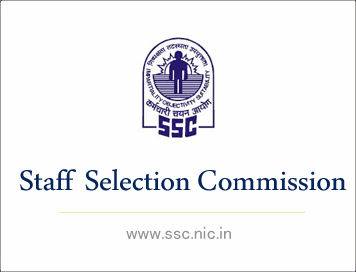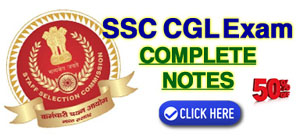NEW! CPO, CAPF PDF Study Notes
NEW! SSC CPO Mock Tests
(Paper) SSC: CPO Sub Inspector - Solved Model Practice Paper
Staff Selection Commission
SSC CPO SI: Model Practice Question Paper (Solved)
1. In which State was the first non- Congress Government set up in
Independent India?
(a) Punjab
(b) Bihar
(c) Maharashtra
(d) Kerala
2. Cheap money means
(a) low rates of interest
(b) low level of saving
(c) low level of income
(d) low level of standard of living
3. Under the rules of the IMR, each member is required to declare the par
value of its legal tender money in terms of the US dollars and
(a) Silver
(b) Gold
(c) Pound Sterling
(d) Diamond
4. The Government takes ‘Ways and means advances’ from
(a) RBI
(b) IDBI
(c) SBI
(d) ICICI
5. Kisan Credit Card Scheme was introduced in
(a) 1991
(b) 1996
(c) 1998
(d) 2000
6. Compared to the rich the poor save
(a) a large part of their income
(b) an equal part of their income
(c) a smaller part of their income
(d) all of their incomes
7. One of the main factors that led to rapid expansion of Indian exports
is
(a) imposition of import duties
(b) liberalization of the economy
(c) recession in other countries
(d) diversification of exports
8. When too much money is chasing too few goods, the situation is
(a) Deflation
(b) Inflation
(c) Recession
(d) Stagflation
9. With which crop has Green Revolution been associated?
(a) Rice
(b) Wheat
(c) Pulses
(d) Sugarcane
10. Who was the first Indian Governor-General of India ?
(a) B. R. Ambedkar
(b) C. Rajagopalachari
(c) Dr. Rajendra Prasad
(d) Dr. S. Radhakrishnan
11. A candidate, to become a member of the Rajya Sabha, should not be less
than
(a) 21 years of age
(b) 25 years of age
(c) 30 years of age
(d) 32 years of age
12. Which Constitutional Amendment gave precedence to the Directive
Principles of State Policy over Fundamental Rights?
(a) 42nd
(b) 44th
(c) 52nd
(d) 56th
13. Nov. 26, 1949 is a significant day in the history of our constitution
because
(a) India took a pledge of complete independence on this day
(b) the Constitution was adopted on this day
(c) India became a Republic on the day
(d) the first amendment of the Constitution was passed on this day
14. Which of the following expressions does not figure in the Preamble to
the India Constitutions?
(a) Sovereign Democratic Republic
(b) Socialist
(c) Secular
(d) Federal
15. Which one of the following Presidents of India served for two terms?
(a) S. Radhakrishnan
(b) Rajendra Prasad
(c) Zakir Hussain
(d) V. V. Giri
16. The maximum strength of the elected members of the House of the People
(Lok Sabha) is
(a) 530
(b) 545
(c) 540
(d) 550
17. How many readings does a non-Money Bill have in each House of the
Parliament?
(a) Two
(b) Three
(c) Four
(d) One
18. Money Bill can be introduced in the State Legislative Assembly with
the prior permission of the
(a) Governor of the State
(b) Chief Minister of the State
(c) Speaker of Legislative Assembly
(d) Finance Minister of the State
19. The Prime Minister who was voted out of power by the Parliament was
(a) Indira Gandhi
(b) Morarji Desai
(c) V. P. Singh
(d) Chandrashekhar
20. The Union Parliament consists of
(a) the President of India
(b) the Council of States (Rajya Sabha)
(c) the House of the People (Lok Sabha)
(d) All of these
21. The Indian National Congress had passed the famous resolution on
“Non-Cooperation” in 1920 as its session held at
(a) Lucknow
(b) Delhi
(c) Bombay
(d) Calcutta
22. Who is known as the ‘Grand Old Man of India’?
(a) Dadabhai Naoroji
(b) Gopal Krishan Gokhale
(c) Bal Gangadhar Tilak
(d) Surendranath Banerjee
23. Which of the following can be considered as the most useful and
outstanding reforms made by Lord Curzon, especially in respect of the people
living in the undivided province of Punjab?
(a) Educational Reforms
(b) Police Reforms
(c) Industrial Reforms
(d) Agricultural Reforms
24. Who among the following was sent as an Ambassasdor to the royal court
of Jahangir by James I, the then King of England?
(a) John Hawkins
(b) William Todd
(c) Sir Thomas Roe
(d) Sir Walter Raleigh
25. ‘Dyarchy’ was introduced in the Government of India Act of
(a) 1909
(b) 1919
(c) 1935
(d) None of these
:: ANSWERS ::
1 (d), 2 (a), 3 (b), 4 (a), 5 (c), 6 (c), 7 (a), 8 (a), 9 (b), 10 (b), 11
(c), 12 (a), 13 (b), 14 (d),
15 (b), 16 (d), 17 (b), 18 (c), 19 (a), 20 (d), 21 (d), 22 (a), 23 (d), 24
(c), 25 (b)


